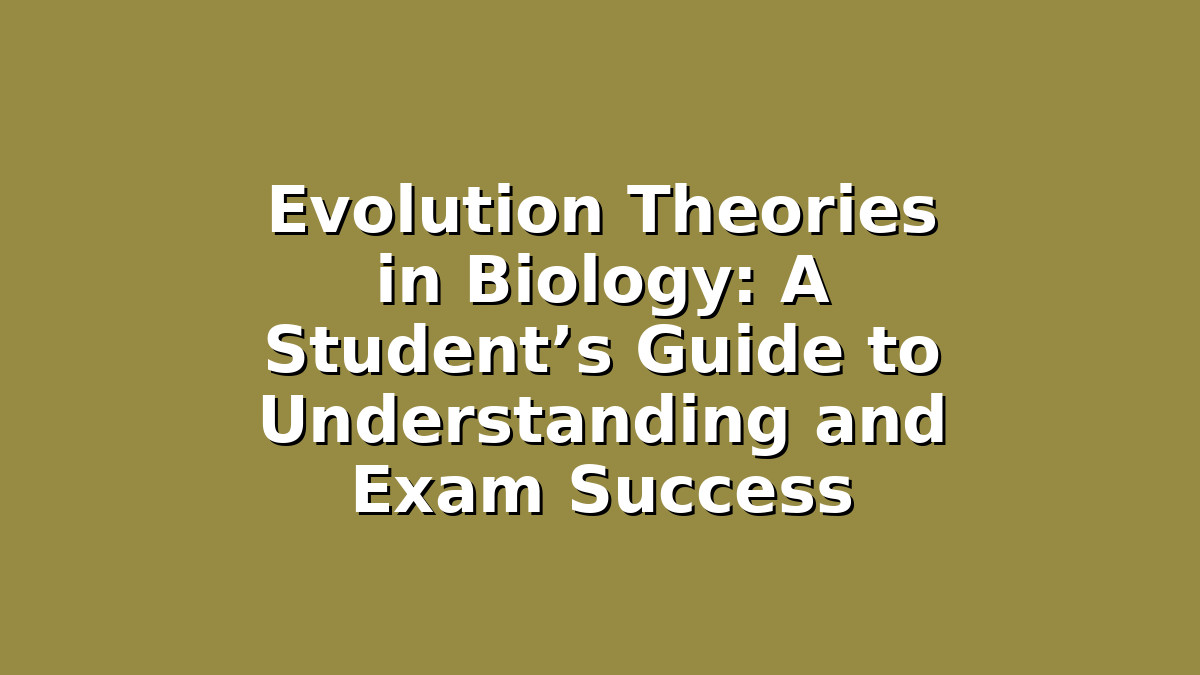Evolution is one of the most important and fascinating topics in biology. Whether you are a high school student preparing for exams or a college student reviewing for a test, understanding the key theories of evolution can boost your confidence and improve your grades. In this article, we will explore the main evolution theories, break down their essential concepts, and share effective study tips to help you master this topic quickly and efficiently.
Introduction: Why Evolution Theories Matter for Students
Evolutionary biology explains how life on Earth has changed and diversified over millions of years. From the famous work of Charles Darwin to modern genetics, evolution provides a framework for understanding the natural world. Exam questions on evolution often test your knowledge of different theories, their mechanisms, and the evidence supporting them. By grasping these concepts, you not only prepare for exams but also develop critical thinking skills applicable across biology.
Let’s dive into three key evolution theories—Darwin’s Natural Selection, Lamarckism, and Modern Synthesis—and learn how to study each effectively.
—
1. Darwin’s Theory of Natural Selection: The Foundation of Evolution
Charles Darwin’s theory of natural selection is the cornerstone of evolutionary biology. Proposed in 1859 after his famous voyage on the HMS Beagle, Darwin suggested that species evolve over time due to variation, competition, and survival advantages.
Key Concepts to Remember:
– Variation: Individuals in a population vary genetically.
– Overproduction: Species produce more offspring than can survive.
– Competition: Limited resources lead to struggle for survival.
– Survival of the Fittest: Those with advantageous traits survive and reproduce more.
– Inheritance: Beneficial traits are passed on to offspring, gradually changing the population.
Study Tips for Darwin’s Theory:
– Use Diagrams: Visual aids like flowcharts showing how natural selection works can help you remember the process.
– Create Flashcards: Write down each key concept on a card with examples (e.g., giraffe neck length, peppered moth).
– Practice Explaining: Teach a friend or record yourself summarizing the theory. Teaching is a powerful way to reinforce learning.
– Relate to Real-Life Examples: Think about everyday examples like antibiotic resistance or animal camouflage to make the theory tangible.
—
2. Lamarckism: An Early but Overturned Theory
Before Darwin, Jean-Baptiste Lamarck proposed a different idea of evolution known as Lamarckism or the Inheritance of Acquired Characteristics. Although now outdated, it’s important to understand Lamarck’s theory because many exam questions compare it with Darwin’s ideas.
Key Concepts to Remember:
– Use and Disuse: Organs or traits become stronger or weaker based on how much they are used.
– Inheritance of Acquired Traits: Traits developed during an organism’s lifetime are passed on to offspring.
– Example: Lamarck believed giraffes developed long necks because their ancestors stretched to reach higher leaves.
Study Tips for Lamarckism:
– Compare and Contrast: Make a table comparing Lamarckism and Darwin’s natural selection to clearly see their differences.
– Highlight Why Lamarckism Was Rejected: Focus on the lack of genetic evidence and modern genetics disproving the inheritance of acquired traits.
– Use Mnemonics: Remember “Lamarck = Learned Traits Passed On” to keep the ideas distinct.
– Answer Practice Questions: Many exams ask you to critique Lamarckism or explain why it was replaced. Practice writing short answers on this topic.
—
3. Modern Synthesis: Combining Genetics with Evolution
The Modern Synthesis is an updated theory that integrates Darwin’s natural selection with Mendelian genetics, forming the basis of contemporary evolutionary biology. Developed in the early 20th century, it explains how genetic mutations and recombination contribute to evolution.
Key Concepts to Remember:
– Genetic Variation: Mutations and gene shuffling create diversity in populations.
– Population Genetics: Evolution is a change in allele frequencies within a population over time.
– Speciation: New species arise when populations become reproductively isolated.
– Natural Selection Acts on Genes: Selection favors certain alleles, influencing evolutionary change.
Study Tips for Modern Synthesis:
– Focus on Vocabulary: Terms like “allele frequency,” “mutation,” “gene flow,” and “genetic drift” are crucial. Use flashcards or apps like Anki to memorize them.
– Draw Genetic Diagrams: Practice Punnett squares, gene pools, and population genetics problems.
– Use Real-World Examples: Think about how antibiotic resistance or sickle cell anemia illustrate modern synthesis principles.
– Solve Past Exam Questions: Apply your knowledge to questions involving genetic mechanisms and evolutionary processes.
—
Effective Study Strategies for Mastering Evolution Theories
Beyond understanding the theories themselves, here are general tips to help you study evolution effectively:
– Set Specific Goals: Break down your study sessions by focusing on one theory at a time.
– Use Active Recall: Test yourself regularly rather than passively rereading notes.
– Make Mind Maps: Connect concepts visually to see how different theories relate.
– Join Study Groups: Discussing with peers can clarify confusing points and provide new insights.
– Use Online Resources: Interactive videos and quizzes can reinforce learning (channels like Khan Academy, CrashCourse, or Bozeman Science are great).
– Practice Writing: Many exams require essay-style answers. Practice summarizing theories in your own words.
—
Conclusion: Confidence Through Understanding
Evolutionary theories are a fundamental part of biology that unlock understanding of life’s diversity and complexity. By grasping Darwin’s natural selection, Lamarckism, and the Modern Synthesis, you gain a solid foundation that will serve you well in exams and beyond. Remember, the key is not just rote memorization but truly understanding concepts and practicing application.
Stay consistent with your study, use the tips provided, and don’t hesitate to ask teachers or classmates for help. With dedication and the right approach, you’ll find evolution theories not only manageable but truly interesting.
Good luck with your studies!
—

Responses